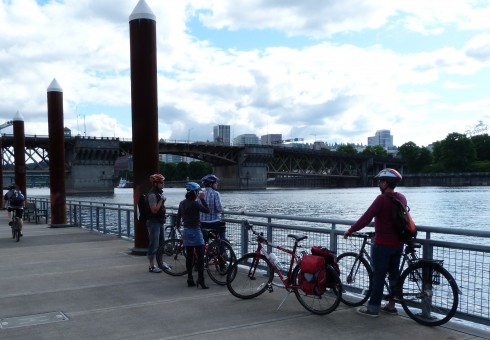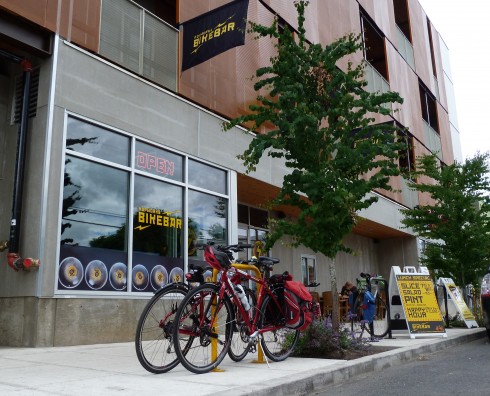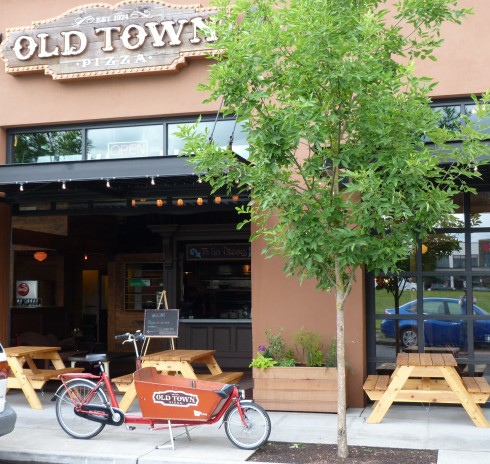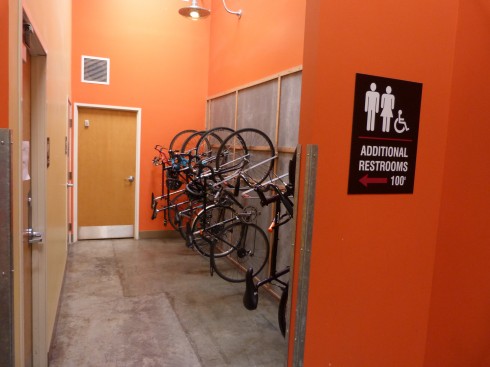Editor’s note: This post was written by Colby Henley one of Tucson Velo’s newest contributors. Henley is a daily bicycle commuter and advocate.

Don’t worry, this isn’t another “Oh, Portland is so great” post. Tucson will never have the trees, architecture, culture or demographics of Portland..and that’s just fine.
But much has been discussed about whether Tucson deserves to be recognized as a Platinum Bicycle Friendly Community, with much of that conversation focused on infrastructure and numbers of riders. So, when I had the chance to travel to Portland last month and do a bit of riding around town, I couldn’t help but make some mental comparisons.
So instead of thinking about what Tucson can copycat from Portland to reach the platinum level, I started to think about what might be indicators that Tucson actually deserves platinum on its own terms. And one thing that came to mind was the recognition of bicyclists by the business community as a valuable clientele.
What I noticed in Portland, beyond the incredible number of bike corrals, was the number and variety of businesses (besides bike shops) either specifically marketing to or accommodating cycling customers and employees. From the Hopworks Bike Bar (with its extra bike locks and air pump), to cargo-bike delivered Old Time Pizza, to indoor parking and showers for employees at Ristretto Roasters, and an employee bike parking cage right by the front door of the New Seasons Market.



I think we can see the beginnings of this in Tucson with six recognized bicycle-friendly businesses, at least one restaurant offering bicycle delivery, and others sponsoring pedicabs. For now, most of this is limited to the 4th Ave and downtown area and will hopefully expand. Despite this progress, we’re still having to beg businesses located along prime bike routes to add even a single bike rack (hint-hint Jimmy John’s).
So what do you think? Is a growing business-cyclist connection something to watch for? What can be done to foster this in Tucson?

Two things that are often missing from discussions of Portland: race and class. Sorry to say it, folks, but in this country, bicycling is a very white activity. And Portland is one of the whitest major cities in America.
As for class, let’s just put it this way: Cycling has long been a leisure-time recreational activity of the affluent. Utilitarian cycling has been a fairly recent development.
Even in that arena, it takes money to get set up as a utilitarian rider. The very poor, and Tucson has many of them, seldom have the means to afford anything better than an old beater or a disposable bike from Walmart.
On the whole, Portland is a much more affluent city than Tucson. And until we develop an economy that isn’t based on real estate booms and busts, that’s how things will remain.
Here’s some interesting info for you Martha. 😉
Bicycling rates don’t very much by income level, but bicycling purposes do. Low-income persons bike mainly for utilitarian purposes, and high-income persons bike more for recreation and exercise.
Pucher, J., et al., 2011
Bicycling renaissance in North America? An update and re-appraisal of cycling trends and policies, Transportation Research A, 45, in press
Bicycling is becoming more diverse. Between 2001 and 2009, cycling rates rose fastest among African Americans, Hispanics, and Asian Americans. Those three groups also account for a growing share of all bike trips, rising from 16% in 2001 to 21% in 2009.
Pucher, J., et al., 2011
Bicycling renaissance in North America? An update and re-appraisal of cycling trends and policies, Transportation Research A, 45, in press
Children from low-income and minority households, particularly blacks and Hispanics, are more likely to bike or walk to school than whites or higher-income students.McDonald, N., 2008Critical factors for active transportation to school among low-income and minority students: Evidence from the 2001 National Household Travel Survey, American Journal of Preventive Medicine, 34, 341-344 Bicycling is highest among whites and Hispanics (0.9% of all trips are taken by bike). For whites, bicycles are mostly used for recreation, while for Hispanics, they are typically used to reach the workplace.Pucher, J., and J. Renne, 2003Socioeconomics of Urban Travel: Evidence from the 2001 NHTS, Transportation Quarterly, 57, 49-77 Hispanics are out there. Just ride one foot south of downtown and you’ll see us. Downtown is the dividing line. 🙂 Also, the bike census needs to start at 6 AM not 7. If Hispanics are riding to work and we have to be there at 7 we leave the house at 6 AM. That means Hispanics are being under counted more than Caucasians since they mostly ride for fun. Here’s some funny things I’ve noticed about Caucasian riders.
P.S. I really liked the article. Maybe if we passed some kind of new law like the one that says all new streets must have bike lanes, but instead we said, all new buildings should have indoor bike racks and showers that would work.
Well, yes, franktellez: PAG’s “bike counts” are loaded with bias, some subtle, some not so. Assuming the biases are witless, it’s unfortunate that they infect public policy. And so it goes…
Thanks for the updated info, Frank. It’s good to see that cycling is becoming more diverse in this country. ‘Bout time, I say.
Think about this for a moment: Where did the cyclovia movement start? It wasn’t in some hip American city like Portland. Uh-uh.
The movement started in Bogota, Colombia, which has levels of poverty that we can scarcely imagine in this country. But poverty or no poverty, it’s a weekly event.
And ISTR reading that, in Mexico City, there’s a car-free event, oh, once a month on one of the major thoroughfares.
A bike is a bike, wither it costs 100 or 2000 it has two wheels and can get you to where you want to go. The class issue needs to be thrown out of your argument, martha.
The problem with the lower priced bikes, especially the ones that come from big box stores like Walmart, is that they’re poorly made and assembled. And they’re heavy. Oh, are they ever.
I also remember reading — in Bicycle Retailer or some other trade publication — that they’re only designed to go 150 miles. That’s all.
We used to get the Walmart bikes all the time when I worked in a local shop. There was very little we could do to make them run properly.
Really sad thing was that the people using them simply didn’t have the money to afford anything better. Sure, we could have told them to head over to BICAS and get something used, but that place was a very confusing set of directions away from our shop.
Maybe Portland has been lucky to have more bike savvy cops, business owners , politicians, planners, et al. to infuse a regard for the bike from the top. Sure, people have to want and be able to afford to ride, but those in a position to create visible advantages for cycling will set the tone. The focus is luring people out of their cars, not off the busses.
The Tuesday Night Bike Ride went to the fireworks display on July 3rd at the Sam Lena Rec. Area. When it was over, we rode out while cars sat in the usual jam, line up. People need to see that as often as possible. The twice-a-year special events fall short for that influence.
This article is right on point. Businesses here don’t think bike riders are their customers. In fact they may even have a negative view of cyclists. I noticed something the first time I rode the Rillito bike path, it wasn’t something subtle that I looked for. It was something that smacked me in the face, I didn’t see any bike path connections to businesses that are next to the path. For instance, the shopping center at 1st Ave. w/ the Walmart, there is no way into the parking lot except you go down the sidewalk along 1st Ave. What?! The Sam’s Club across from Tucson Mall is the same way, you have to go to the sidewalk on the street. If I had a business along a bike path, I’d make sure there was a connector path running straight from the bike path right into my property. The only folks I know who are onto this is the Loop Bike Shop. They have the right idea, but hey, they’re bike people.
Okay, 3wheeler and everyone else, why don’t we have bicycling cash mobs? Let’s prove to these businesses that we do indeed know how to spend money.
Hold that thought Marha – I have an idea for that in the near future.
Interesting idea, Martha. You and Colby may be on to something. Please keep us informed.
Portlander here. We have a few nonprofit organizations that take donated beater bikes (non department store bikes – they dont last, as you note) and fix them up using volunteers to sell at very low cost to low income community members. I believe they run off of donations from the business community, although I’m not sure. That type of model maybe should be explored in Tucson, as it is a very inexpensive way to get the poor a set of wheels!
http://www.communitycyclingcenter.org/